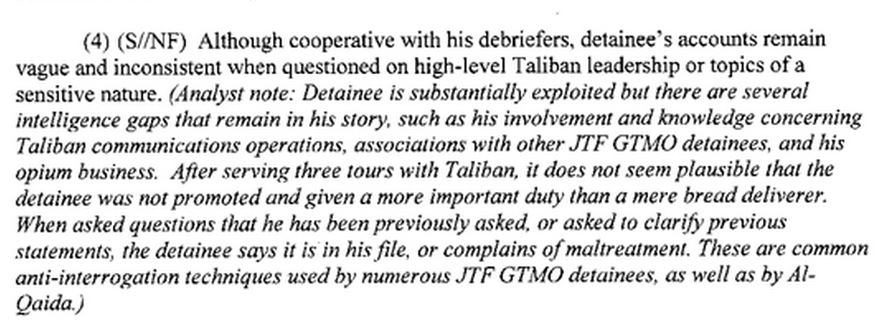Rauf Exploited One Last Time, Now Latest Drone Victim
On January 30, I noted how the varied history of Mullah Abdul Rauf Khadim had seen him on many different sides of the conflicts in Afghanistan and Pakistan. His history depends on whoever is describing it, but it is clear he spent time at Guantanamo, where leaked documents said that he was “substantially exploited“. He was released from Guantanamo and held for at least some time in Afghanistan’s notorious Pul-e-Charkhi prison. Many reports put him serving on the Quetta Shura of the Afghan Taliban at a later point and getting quite close to Mullah Omar. Most recently, he was said to be an active recruiter for the Islamic State and perhaps even serving as the IS governor of the region.
Multiple reports today state that Rauf has been killed by a US drone strike in Afghanistan. From the Reuters report:
A missile-firing drone killed six people in Afghanistan on Monday including a veteran militant believed to have defected to Islamic State (IS) from the Taliban, Afghan officials said.
The senior militant, former Guantanamo Bay detainee Mullah Abdul Rauf, was killed in the violence-plagued southern province of Helmand, officials there said.
Police chief Nabi Jan Mullahkhel said Rauf was travelling in a car when the drone attacked. The other casualties included his brother-in-law and four Pakistanis, Mullahkhel said.
More details from the area:
Afghanistan’s main intelligence agency, the National Directorate of Security (NDS), said in a statement Rauf was in charge of IS in southwestern Afghanistan and he was killed just after mid-day in “a successful military operation”.
Helmand’s deputy governor, Mohammad Jan Rasulyar, said Rauf’s membership of IS could not be confirmed but his associates were dressed in black outfits often worn by IS members.
“It is too early to confirm that he was Daish but his people were wearing the same clothes and mask,” Rasulyar said, referring to IS.
It is hardly surprising that the CNN account of his death would open with the recidivist angle:
He was a Taliban commander captured by the United States and held at Guantanamo Bay. But he was let go and returned to Afghanistan. Mullah Abdul Rauf went on to become a recruiter for ISIS in Afghanistan.
He was killed in a drone strike Monday, two officials told CNN.
And, as with seemingly all stories of this type at the early stages, the possibility that Rauf escaped has been presented. Khaama Press relays the same reports of Rauf’s death, but adds this to their story:
However, Pacha Gul Bakhtyar, Security Officer of Helmand Province had told Khaama Press earlier in the afternoon that Mullah Abdul Rawouf Khadim sustained serious injuries while four of his fighters were killed in the attack.
He said that Mullah Abdul Rawouf Khadim was traveling along with a group of his people in a Saracha vehicle when their vehicle was targeted, leaving Khadim seriously wounded and four of his people killed.
He said that Mullah Abdul Rawouf has escaped in wounded conditions.
So, while Afghanistan’s National Directorate of Security states outright that Rauf was in charge of IS recruiting for the region, the Ministry of the Interior was insisting as recently as Sunday that the presence of IS fighters in Afghanistan was nothing more than a publicity stunt:
Rejecting the infiltration of the Islamic State (IS) fighters to Afghanistan, the Ministry of Interior (MoI) has said the rumors about the sightings of theses fighters were nothing more than publicity.
MoI spokesman Sediq Sediqqi at a press conference on Sunday in Kabul said that the security agencies were aware of the movements of all enemies of the country.
He warned the Afghan National Security Forces (ANSF) would suppress all rebel groups whether they were operating under the name of IS or other brands.
As a final note, the case of Rauf and his constantly changing sides should be seen as the rule for areas where the US military has engaged in its misadventures rather than an exeception. Other stories in today’s news note disputes over Afghan police with ties to the Taliban and Iraqi militias operated by a member of Parliament attacking Iraqi citizens at the same time they pursue ISIS.
So, of course, the US should promptly arm troops in Ukraine, as well, so that we can have another region where US arms raise the stakes the rapid changing of sides in a conflict.


